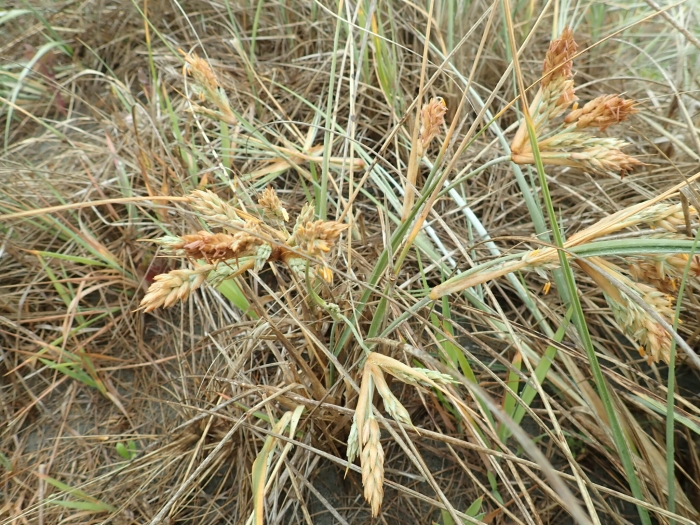Hairy Spinifex
(Spinifex sericeus)
Hairy Spinifex (Spinifex sericeus)
/
/

Arnim Littek
CC BY 4.0
Image By:
Arnim Littek
Recorded By:
Copyright:
CC BY 4.0
Copyright Notice:
Photo by: Arnim Littek | License Type: CC BY 4.0 | License URL: http://creativecommons.org/licenses/by/4.0/ | Rights Holder: Arnim Littek | Publisher: iNaturalist | Date Created: 2023-11-19T11:43:32-08:00 |

























Estimated Native Range
Summary
Spinifex sericeus, commonly known as hairy spinifex or beach spinifex, is a dioecious perennial grass native to coastal sand dune systems of Australia, New Zealand, New Caledonia, and Tonga. It is particularly adapted to open, sandy environments where it plays a crucial role in dune formation and stabilization. This species thrives in harsh coastal conditions, often being one of the first colonizers on foredunes, where it helps to trap and stabilize loose sand with its extensive system of horizontal runners, branched stolons, and rhizomes.
Hairy spinifex has flat, densely silky leaf blades that can withstand the abrasive effects of wind-blown sand. Its inflorescences are sexually distinct, with male and female flowers on separate plants. The female inflorescence is notable for detaching at maturity and tumbling along the beach, which aids in seed dispersal. This grass is highly valued for its rapid growth and sand-binding properties, making it an essential plant for coastal dune stabilization projects. In cultivation, it requires full sun, well-drained sandy soils, and can tolerate drought and saline conditions. While it is not typically used in ornamental horticulture due to its sharp leaves and sprawling habit, it is indispensable in coastal restoration and erosion control efforts. Potential problems include its aggressive spreading, which can be an issue if not managed in a controlled environment.CC BY-SA 4.0
Hairy spinifex has flat, densely silky leaf blades that can withstand the abrasive effects of wind-blown sand. Its inflorescences are sexually distinct, with male and female flowers on separate plants. The female inflorescence is notable for detaching at maturity and tumbling along the beach, which aids in seed dispersal. This grass is highly valued for its rapid growth and sand-binding properties, making it an essential plant for coastal dune stabilization projects. In cultivation, it requires full sun, well-drained sandy soils, and can tolerate drought and saline conditions. While it is not typically used in ornamental horticulture due to its sharp leaves and sprawling habit, it is indispensable in coastal restoration and erosion control efforts. Potential problems include its aggressive spreading, which can be an issue if not managed in a controlled environment.CC BY-SA 4.0
Plant Description
- Plant Type: Grass
- Height: 1-2 feet
- Width: 7-10 feet
- Growth Rate: Moderate
- Flower Color: N/A
- Flowering Season: Summer
- Leaf Retention: Evergreen
Growth Requirements
- Sun: Full Sun
- Water: Low
- Drainage: Fast
Common Uses
Drought Tolerant, Erosion Control, Groundcover, Low Maintenance, Salt Tolerant
Natural Habitat
Coastal sand dune systems
Other Names
Common Names: Hairy Spinifex
Scientific Names: , Spinifex sericeus, Ixalum inerme,
GBIF Accepted Name: